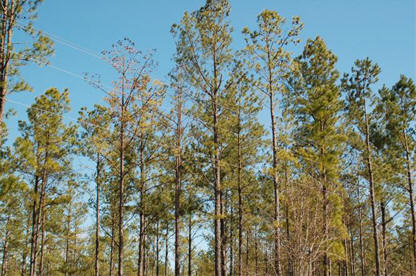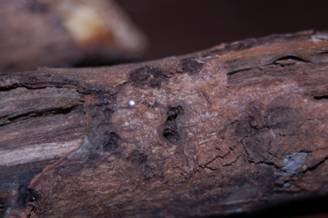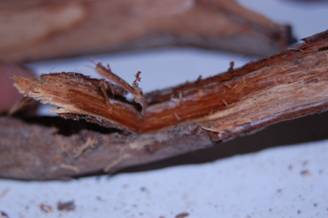
Importance: Pine decline is a disease complex resulting from the interactions of both biotic and abiotic stressors. More common than previously thought, this disease is often misdiagnosed as either littleleaf disease or annosus root rot. Because of the emphasis in planting loblolly pines for timber production, this disease complex is most prevalent in loblolly pine plantations. Shortleaf pine, however, is also quite susceptible to this disease, while longleaf pine and other conifer species are less susceptible. Thus far, evidence shows that slash pine is not susceptible to the factors that result in pine decline. Affected pines expressing declining symptoms can succumb within two to three years. Pine decline usually exists with trees that are over 35 years of age, but can exist in trees as young as 12 years old.
Identification: A specific soil type is not generally associated with this disease; however, pines in predominately loam, sandy loam or sandy clay loam are quite susceptible. Tree age, topography and organic matter content in the soil are more associated with pine decline than soil type. Management history of the site is also a contributor to the occurrence of this disease in pine stands. Recent prescribed burns, past agricultural practices and lower vegetation density are contributing factors to pine decline. The most significant factors to this disease complex, however, are abiotic conditions such as drought or storm damage.

Symptomatic pines will have bark beetles and Leptographium fungi present in deteriorating roots. Infected primary roots will have blue-stain and resin-soaked lesions caused by the Leptographium fungi (L. truncatum, L. procerum, L. terebrantis, L. serpens, and L. huntii). This group of fungi is present in the roots because of their association with the various root-feeding bark beetles (Hylastes salebrosus, H. tenuis, H. porculus, H. opacus, Pachylobius picivorus, Hylobius pales, and Dendroctonus terebrans). Just like their above-ground counterparts, these root-feeding insects will vector the Leptographium fungi or create wounds in the roots that will allow the fungi to enter. Beyond the lesions, the fine roots are either damaged or significantly reduced in number.
These below-ground indicators on affected pines are initially difficult to recognize unless roots are exhumed and examined. However, the above-ground symptoms are easily noticeable and are similar to those associated with littleleaf disease or annosus root rot. Thinning crowns with short, chlorotic needles are the primary symptoms. Once these above-ground symptoms are noticed, the below-ground symptoms (resin-soaked, stained roots) have been present for some time and the affected pines are severely declining. A stand with this disease complex will exhibit scattered pines with declining symptoms. In some instances, a “disease circle” or a uniform pattern of dying pines will exist. In most cases, however, there will be apparently healthy pines right next to declining ones.
Prevention: Currently, the procedure to prevent pine decline is still being determined. Insecticides and fungicides are not available for controlling this disease complex. Since the infection and damage occur underground, methods for identifying are difficult. The best prevention method is to properly manage the pines based on the specific site. Know the management history of the stand. If the land was once managed for agriculture, then certain pine species are more likely susceptible to pine decline. Also, the soil type can be a factor. The particular soil type can determine the pine species that are ecologically adapted to the site. Slash pine is the least susceptible to this disease, but its natural range is very limited. Longleaf pine is also less susceptible to pine decline than loblolly pine, but its growing habitat is also quite site specific. The only guaranteed management recommendation is to convert the land area into a non-pine (hardwood stand or a pasture) stand.

If loblolly pine is your choice for planting, the best prevention method is to keep the stand healthy. Certain abiotic conditions can not be controlled (like a drought) but particular management regimes can. Do not thin stand or conduct a prescribed burn during an adverse abiotic episode. These practices can cause further damage to the root system of residual pines that are already stressed. With the combination of root trauma and stressed conditions, these pines may become subjected to pine decline.
If pine decline has been confirmed, conduct a survey to determine how many trees are in decline. If the percentage is greater than 30, the best recommendation is to clearcut the stand. As far as replanting the site with loblolly pines, the same outcome may occur several years later once the pines reach a certain maturity. If a less susceptible pine species can be planted on that site, try planting that particular species. If the stand has 10% or less pines declining, no thinning or cutting activity is recommended. Observe the stand for one year to see if other pines become symptomatic. If not, the stand can be left alone and just accept the 10% loss. If the dying pines are just in one small area of the stand, then perhaps that section of the stand can be harvested. The professional recommendation at this time, is contingent on the number of declining pines and the site. More research is currently being done to give precise and effective management recommendations and control methods for pine decline.
Additional Resources